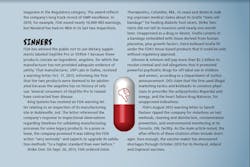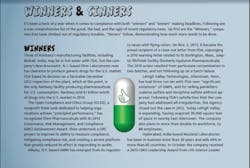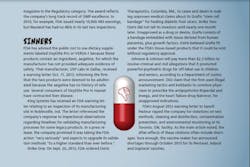Title VII, the supply chain provisions of FDASIA, attempts to modernize an increasingly global network through which ingredients, active pharmaceutical ingredients (APIs), and finished products funnel into manufacturing and distribution channels. Title VII significantly mirrors the European Union’s 2013 Falsified Medicines Directive.
The law recognizes that the global supply chain is beyond the control of any one regulatory body, particularly that FDA cannot be in all places at all times. It also grants the Agency enforcement clout beyond U.S. borders — powers whose legal status and practicality have not yet been tested. Nevertheless, the Agency and many observers believe that Title VII can achieve its goals through application of tools the agency already uses such as data collection and analysis, risk-based decision-making and facility oversight, and close collaboration with foreign regulators.
At an FDA-hosted public meeting on Title VII in August 2013, Commissioner Margaret Hamburg, M.D., noted that “while FDA’s mission and focus remains domestic, we rapidly are becoming a global agency.”
FDA’s extra-territorial authority has not yet been challenged in court, and some question if the Agency would persevere in such cases. Domestic firms that refuse inspects are served with an inspection warrant. “But the consequences for similar behavior overseas are unclear,” says James Johnson, a former FDA attorney and current Senior Associate at the healthcare group of law firm Hogan Lovells. “I’m not sure how this aspect of Title VII will work in practice.”
HOW SERIOUS IS THE PROBLEM?
Thirty years ago most U.S. pharmaceutical producers sourced ingredients and APIs domestically, or from a few trusted overseas sources. Today, companies import nearly 40% of finished drugs, and 80% of APIs and other ingredients, from more than 150 countries. Regulation and oversight is lax, by U.S. standards, in all but a handful of foreign jurisdictions.
In just the last decade, pharmaceutical imports have quadrupled. In 2013, U.S. drug companies and distributors received 24 million shipments, from more than 130,000 exporters and 300,000 facilities. More entities than ever “touch” materials and products, which frustrates meaningful enforcement.
Overseas FDA inspections have increased as the supply chain became increasingly global and fragmented. FDA conducted more than 2,700 inspections in 2013, a nearly four-fold increase over 2008. Under this burden and an anticipated increase in enforcement, the Agency can no longer rely on its own inspectors to cover the globe. Thus, Title VII’s reliance on collaboration with foreign regulators and producers has become a necessity.
Precise data on what the World Health Organization terms medicines that are spurious, falsely labeled, falsified, or counterfeit (SFFC) are unreliable. Everyone agrees, however, that SFFC products comprise a tiny fraction of pharmaceutical supply in developed nations: Just 0.2% of drugs sold within the U.S. fall into this category, most of them from Internet sales.
Counterfeiting is a more serious concern in developing countries, where half or more of medicines are diluted, expired, adulterated or devoid of active ingredients. Recognizing the value points within the supply chain, purveyors of bogus medicines have shifted their focus from APIs and ingredients to higher-value finished products.
SFFC incidents, while rather uncommon, still tend to garner headlines. Ethylene glycol contamination in foods and medicines has caused 600 deaths worldwide. Nor are big brands immune: Lipitor, Tamiflu, several insulin products and drugs for a variety of serious disorders have been found to be adulterated or counterfeit. The value of many drugs assures that a counterfeit operation will be profitable, if even a fraction of their goods get through.
Although third-world supply chain problems have not yet spilled over into the United States to a significant degree, the potential healthcare implications of adulterated or sub-potent medicines abroad are serious. Speaking at the FDA meeting, Martin VanTrieste noted the persistence of resistant malaria in Africa and the substandard drugs used to treat it. Mosquitos bearing the disease, he stated, is “one plane journey away, one cargo container, one shipment from getting into south Florida.”
RISK AND REPUTATION
“Risk” has become a pharmaceutical industry buzzword, but its application to facility oversight is straightforward: Facilities with good track records will be audited less frequently than those with past issues.
Daniel R. Matlis, president of advisory firm Axendia (Yardley, Penn.) likes the new risk-based approach to inspections, and FDA’s reliance on leading indicators for triggering audits. “Leading indicators should be tied into manufacturing data and standardized quality metrics such as Batch Failure Rates, Right First Time and Out Of Specification,” he says. This data, Matlis believes, will provide a window into a manufacturing site’s current compliance status.
Lagging indicator metrics might be simply recall data. But according to Howard Sklamberg at the Title VII conference: “We don‘t want to be in the situation of the firemen putting out the fire. We would rather be hoping that the firm will design a fire-resistant building in the first place.” Some metrics the Agency has considered are standards like batch failure rate, right first time and products that are out of specification. “We’re looking for metrics that firms already keep.”
But as Howard R. Sklamberg, Director, Office of Compliance, Center for Drug Evaluation and Research at FDA observed at a July meeting, reports of adverse supply chain events may be interpreted either that problems exist, or that a company’s vigilance is high. “When there are more recalls you can say that a firm has gotten control of its quality system. You get a spike up in recalls because they’re detecting and removing products.”
How the Agency will collect ongoing manufacturing data, and the form in which companies submit it, are unclear. Whether data is submitted regularly, or provided upon FDA request, submissions will serve as “pre-audits” or even replace on-site visits. The exact wording in the law gives cause for hope:
“Any records or other information that the Secretary may inspect … shall, upon the request of the Secretary, be provided … in advance of or in lieu of an inspection, within a reasonable timeframe, within reasonable limits, and in a reasonable manner…” (italics/emphasis mine)
In other words, the Agency can request any data remotely to which it is entitled onsite. Conserving FDA resources in this manner comes at a cost, however: The Agency must now create metrics for determining what events or circumstances warrant information requests, or onsite inspections. “FDA is preparing to grade companies on a bell curve,” Matlis observes, “where companies at the bottom should expect additional scrutiny.”
Another drawback of written audits is they create incentives for falsifying data. Anyone who believes “it can’t happen here” is urged to visit the FDA enforcement pages, which describe every transgression from sub-potent medicines to bogus repair reports for devices — most of which involve finagling data on safety and/or efficacy. Transgressions, sadly, are not limited to mom-and-pop shops.
Organizations like U.S.-based RX-360, and Exipact, a new European organization, are developing protocols for standardizing audits and for broadening access to supplier audit information. “This will allow for standardized audits of many more suppliers,” says Daniel Kirsch, “which can help fill the gaps at resource-limited regulatory agencies.”
James Johnson, a former FDA attorney and current Senior Associate in the Healthcare Group at law firm Hogan Lovells (Washington, D.C.), explains that risk-based inspections will somewhat lighten FDA’s audit load, but they make sense for public safety as well. “The agency needs to focus on products that are difficult to make. In any event, this law gives them more wiggle room.”
UNIQUE FACILITY IDENTIFIER
Under Title VII, all entities engaged in pharmaceutical trade within U.S. markets must register annually with FDA through a unique facility identifier. To an extent that is unclear, these firms must also document their suppliers. Presumably, finished products would bear the unique identifiers of every entity that touches the product by contributing materials, ingredients or APIs, or by transporting or storing them.
Products lacking facility identifiers will be considered misbranded. “FDA wants to identify not just the source of the final product, but everything that went into it, who touched it along the way, almost like a chain of custody” explains K.R. Karu, Director of Pharmaceutical Industry Solutions at quality software provider Sparta Systems (Hamilton, NJ). “So if your company name is on the final product, you’re responsible for it and everything that went into it.”
Yet it would not be difficult for importers or manufacturers to get caught in the web of technicalities surrounding this provision. Let’s say a product has two actives, one sourced from a compliant facility, the other not. A U.S. firm that puts these ingredients together may be unaware of the regulatory action against the non-compliant supplier, or may have received shipment of the API concurrent with or shortly before the FDA citation. “Under the law, that product is adulterated,” says James Johnson. “FDA does not need direct evidence that your product is actually adulterated.”
Unique identifiers are also expected to help reduce drug shortages, which is another goal of Title VII.
Drug shortages affect hundreds of products in every therapeutic category. Many recent shortages, according to Michael Lucas, CEO of supply chain technology firm Frequentz, arise from poor compliance, when regulators hold products instead of releasing them into the distribution chain.
Compliance mishaps related to shortages usually result from issues intrinsic to the manufacturing system, for example, delayed delivery of a key ingredient or products falling out of specification at the plant. Lucas fears that additional enforcement may worsen shortages by holding up product distribution due to real or perceived non-compliance.
As favorably as he views unique facility identifiers, Lucas believes they do not go far enough. “They are facility- and origin-based, but do not adequately account for inventory. The law lacks full inventory visibility, which is needed to expose weaknesses in the global supply chain, and identify where shortages will occur.”
Yet, identifiers are a “good first step” towards global compliance, Lucas says. “It’s a significant initiative that will lead to higher quality and serialization, and reduce drug shortages.”
Together with positioning and tracking technologies, identifiers will enable creation of a global supply location system that “knows” the whereabouts of products — perhaps even ingredients — at all times, from factory to distributor. This, says Lucas, will allow greater control over cold-chained products that decline in potency or become unsafe if refrigeration breaks down. It will also provide crucial data on where all ingredients and products have been.
Despite the concern over shortages, FDA seems to have the problem under control. The Agency reported 251 drug shortages in 2011, but just 117 in 2012, when the Agency took credit for preventing more than 280 shortages. In October 2013, FDA proposed rules that would require major manufacturers to provide information on manufacturing changes that could lead to or trigger shortages.
A CALL FOR SOMETHING GREATER
Title VII calls for greater cooperation with foreign regulators. Experts appear split on the wisdom of this provision.
Karu calls FDA’s newly acquired recognition of foreign government inspections, and willingness to act on them, “dramatic.” He relates a recent incident where foreign regulatory activity triggered inspections at a manufacturer’s U.S. installation. That, he says, will occur more frequently and will boost oversight. “If XYZ company has major problems with deviations in Frankfurt, and their plant in Florida manufactures the same product for U.S. consumption, regulators will be interested to see if it’s a localized problem or systemic.”
Not everyone agrees that this level of cooperation will work as well in the negative as in the positive.
“The culture overseas is different,” says Pedram Alaedini, Managing Partner at Iron Hill Capital (Princeton, NJ). Consequences for non-compliance are less severe in many developing nations compared with stateside; foreign inspectors may not be as knowledgeable or consistent. “Even in Europe,” he adds, “regulators favor their own manufacturers.”
And while risk-based inspections are necessary given the scope and breadth of policing the global supply chain, Alaedini fears that “lots of bad habits can take hold” if the time between inspections stretches out to three or four years. “A lot of things can change even in two years.” So while partnering with overseas regulators is fine, relying on them exclusively, Alaedini says, is a mistake.
Karu downplays dissimilarities between FDA and overseas regulators because of the profit motive: Pharmaceutical exports are big business, particularly for developing nations. “Perhaps bets are off for their domestic products, but they get serious when products are headed for the U.S., Europe and Japan.” Chinese manufacturers have reached the point of building separate facilities for domestic and export markets. “They get the message,” Karu adds. “Their export plants are state-of-the-art and they do everything properly.”
Yet the great distances involved in cross-border collaborations, and FDA’s dubious legal standing overseas, inject an uncomfortable level of uncertainty for the Agency’s expectation that international enforcement protocols will develop harmoniously, and according to tight FDA standards.
Johnathon Marshall, a Partner at PriceWaterhouse Coopers (London, UK), is even more sanguine: “There is no guarantee that these guidelines will be adopted globally outside the industrialized countries.”
A DISSENTER’S VIEW
Hedley Rees, Principal at Biotech PharmaFlow (Cardiff, Wales), believes that the proliferation of third-party relationships will sink the noble goals of Title VII. “Ownership is missing. And unless companies developing and selling drugs take the lead, no amount of track and trace and e-pedigree legislation will fix the problems.”
Rees advises that supply chain management begin during drug development, lest supply and sourcing defects persist throughout the product lifecycle. He also calls for minimal handovers and “strategic procurement” that involves thorough vetting of suppliers.
The evolution of pharmaceutical procurement and manufacturing is a story in itself. A vastly different supply chain existed 30 years ago, before the patent cliff, before approvals of innovative drugs stalled, and as the blockbuster model was taking hold. Large companies began to focus on opposite ends of the value chain — discovery research and marketing — while outsourcing critical operations like manufacturing, analytics and clinical development. Today, even drug discovery occurs substantially overseas. Outsourcing improved bottom lines, but innovator firms lost control over drug discovery, manufacturing, clinical trials and sourcing.
Rees asks why such highly profitable enterprises would “try to reduce their financial exposure and cost base when the risks of non-compliance and potential harm to patients were so high.”
KICKED INTO THE LONG GRASS
“Third-party contractors, some quite large themselves, are now pre-eminent,” Rees adds, “which has led to a complete reversal of power whereby innovation and operating changes cost significant amounts of money. Sponsors are reluctant to pay, so modernization initiatives like process analytical technology and quality by design just get kicked into the long grass.”
Rees also disagrees that the most egregious disasters, like the Heparin incident of the late 2000s, could have been prevented by today’s supply chain technologies like track and trace, or even through legal constructs like Title VII.
“Weaknesses in procurement processes were the culprit. Instead of applying proper due diligence in choice of supplier, they just accepted at face value what they were told.” Rees says. “This incident, more than any other, demonstrates the abysmal state of procurement competency in this industry. In 1991, a McKinsey study placed Pharma at the bottom of the pile for procurement competency and things have changed little, if any, since.”
TITLE VII: A NEW HOPE
Globalization has enabled the pharmaceutical industry to enter the global markets world and thereby raise health standards worldwide. But attached to those benefits are challenges to ensure authenticity and quality. Stakeholders the world over have placed their hopes on FDASIA Title VII to help meet those challenges.
Various pieces of Title VII are now falling into place. In early 2013, the Federal Sentencing Commission allowed FDA to impose higher penalties for counterfeit drugs. The Agency has also proposed rules to enhance its ability to detain suspect drugs, and proposed a framework for what constitutes obstruction during inspections.
“FDASIA Title VII is a start and will help, but it will not provide the entire level of supply chain security that is required,” says Daniel Kirsch, President of Triton Consulting (Beverly, Mass.). “The challenge, to both pharmaceutical manufacturers, importers and their suppliers are the significant costs involved in compliance.”
Daniel Matlis notes that as difficult as Title VII will be on the world outside of FDA, implementing it internally at the Agency will be no cakewalk, either. “The Agency must invest in business intelligence and high-level analytics to assist in aggregating data identifying outliers, even ones that are not obvious. Being in the middle of the curve doesn’t necessarily mean you’re ok. There must also be minimum standards.”
Published in the December 2013 edition of Pharmaceutical Manufacturing magazine


